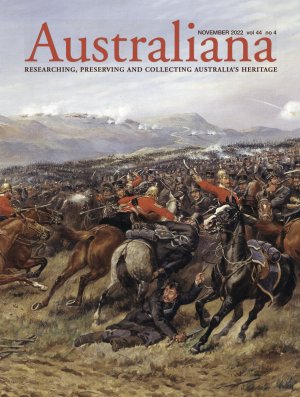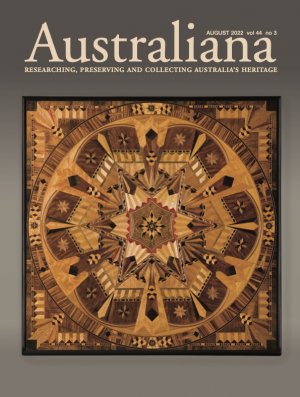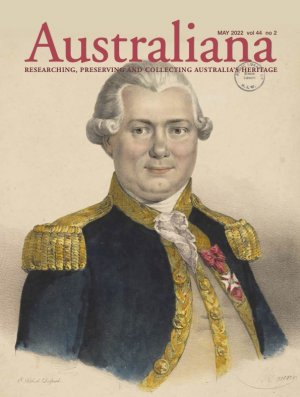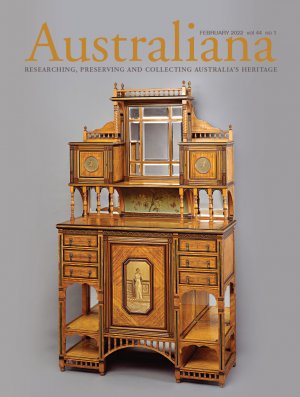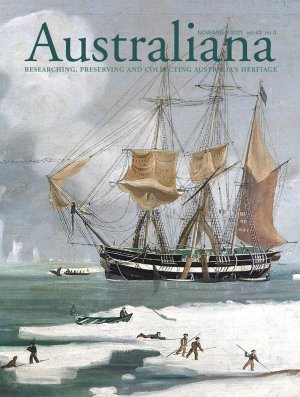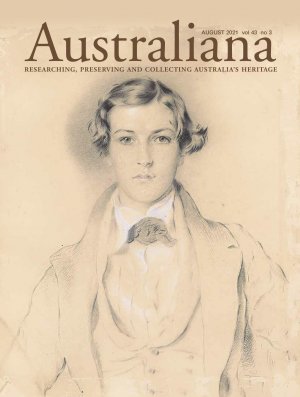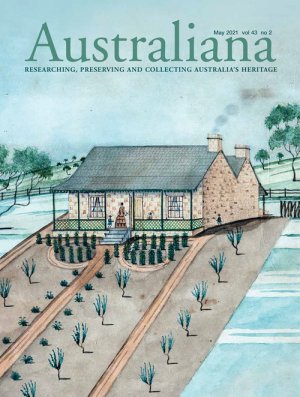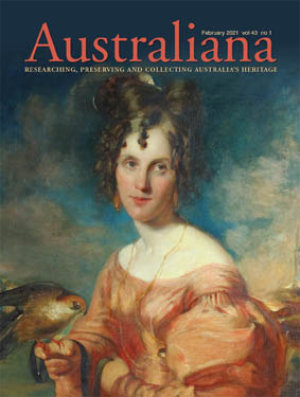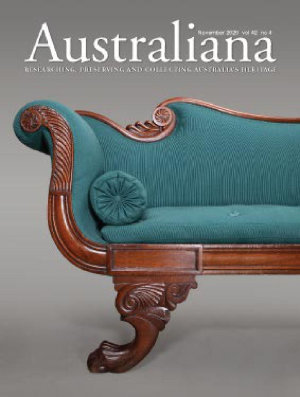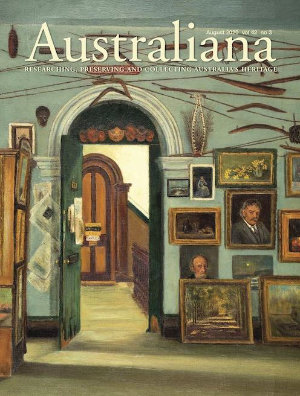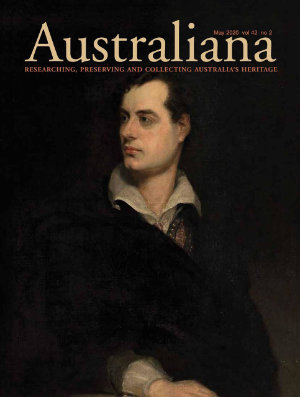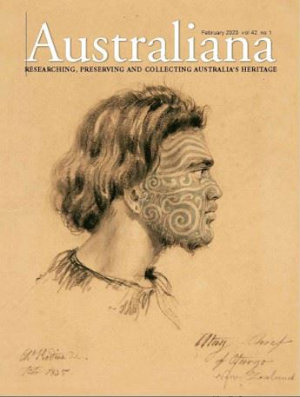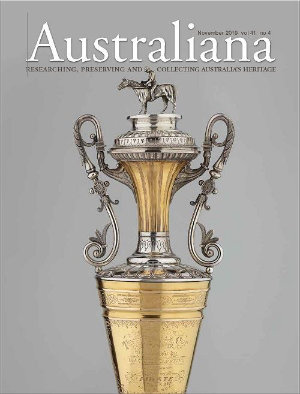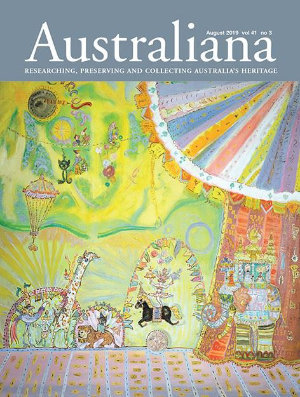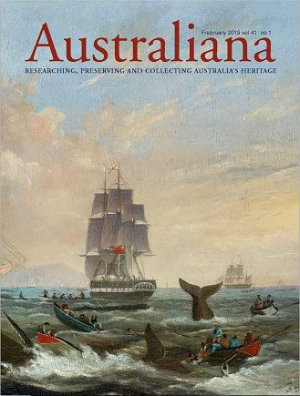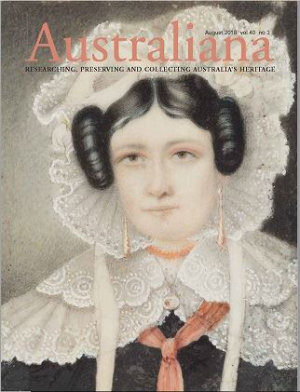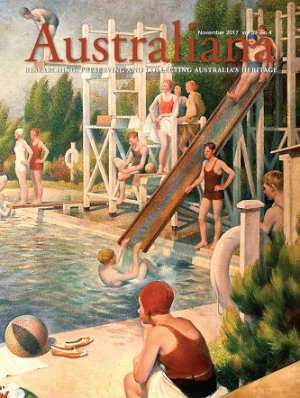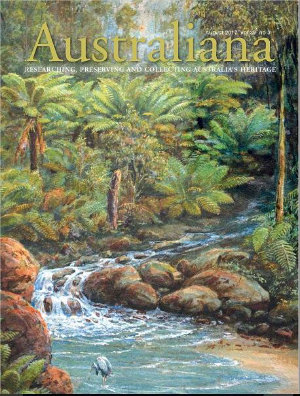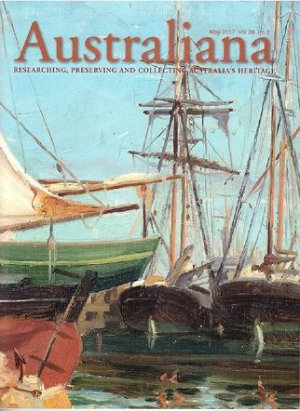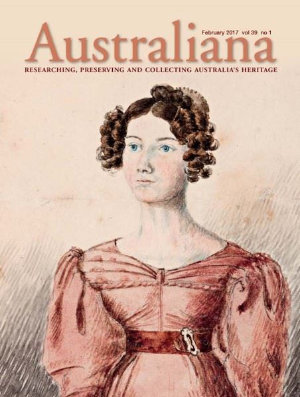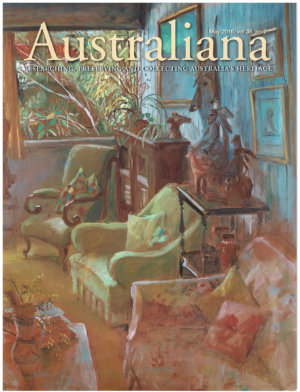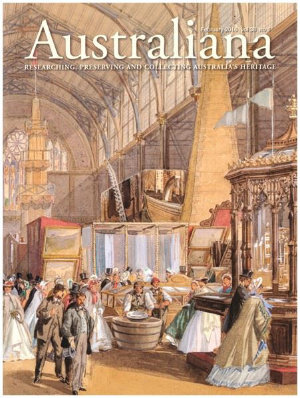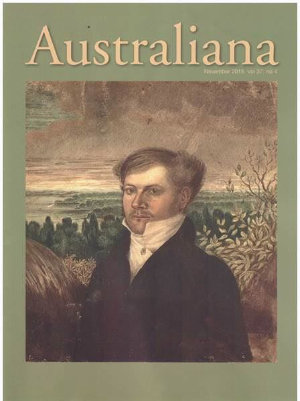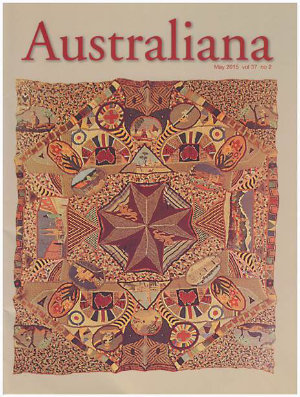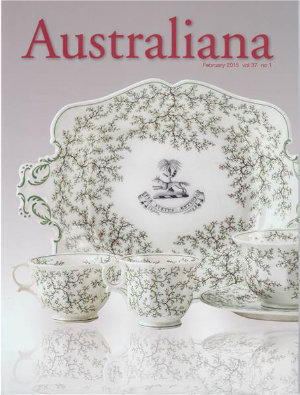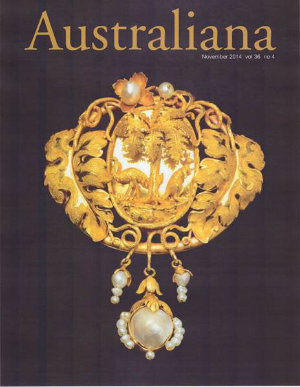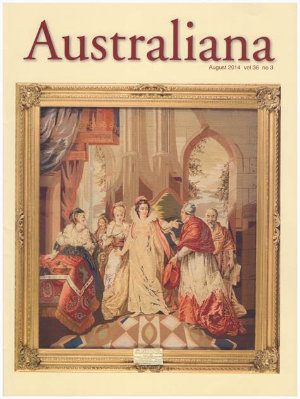Brisbane painter and art teacher Mary E. Jones has escaped recognition for 130 years. She would not be alone in that fate: over time, many aspiring painters and their works disappear from history. Timothy Roberts reveals some details about Miss Jones’s career and her impact as a woman artist in Brisbane betwe...
While the artist H. C. Simpson (1879–1966) depicted subjects such as Mount Warning in northern NSW, his output is emphatically linked with the early years of the ‘Gold Coast’ and specifically the resort towns of Coolangatta, Currumbin and Tweed Heads. Although his work is not held in particularl...
Two paintings of the Tomb of Father Receveur and the La Perouse Monument at Botany Bay by F. C. Terry mark the end of a significant episode in the exploration and scientific research of the Pacific in the late 18th century, extending from the arrival of the First Fleet at Botany Bay in January 1788 to the great...
Paintings on gum leaves are a unique Australian tradition, which began in the 1850s or 1860s and still continues today. The earliest practitioner recorded is Arthur William Eustace (1820–1907), who was born in England and arrived in Victoria with his family in 1851. He found work as a shepherd near Chiltern i...
A small watercolour painting reveals remarkable similarities between the 1919 pandemic and that of our times.
In the Middle Ages and Renaissance, workshop and guild traditions were based on the principle of emulation, with apprentices learning by copying the works of their masters. In painting, the practice was gradually regularised and systematised in the curricula of emergent national academies of art, beginning at t...
Artists in early Australia were usually trained in Britain and Europe in the Classical tradition going back to ancient Greece and Rome. David Hansen explores the possibility that, in the composition of his paintings created in Van Diemen’s Land, Benjamin Duterrau was influenced by Renaissance and Classical mo...
English painter John Glover once owned two Italian landscapes by the French painter known as Claude Lorrain. Claude's work prompted artists and tourists to view landscape in terms of art, so they would often look at 'Picturesque' scenery reflected in a tinted convex mirror known as a ‘Claude glass’, simulat...
John Roy Eldershaw (1892–1973) was a landscape artist who worked primarily in watercolours. During his lifetime, he
was proclaimed to be ‘destined to leave unmistakable footprints in the sands of time’. In 1973 Sir Erik Langker, the arts administrator and influential member of
the Sydney arts establishm...
Between arriving in Hobart Town as a convict on 3 August 1831 and the last evidence of his residing in Van Diemen’s Land in 1847, Meshach Stevens painted a very competent copy of a famous print after William John Huggins titled Northern Whale Fishery, published in London in 1829 (plate 1).1 For almost ...
Dr Erickson concludes her story of the professional women artists who commenced working in Western Australia before World War I. All were born in South Australia or England, coming to Western Australia later, most as young adults and often with other family members. Their careers began in the heady years of the...
Thomas Griffiths Wainewright (1794–1847) was early colonial Australia’s most sophisticated and glamourising portraitist. The current exhibition,
Paradise Lost – Thomas Griffiths Wainewright, at the Tasmanian Museum and Art Gallery (TMAG) features 40 works by Wainewright together with contextual works by ...
Continuing our story of the women artists working in Western Australia before World War I, we will now turn to three ‘Angels’ who came, saw and conquered, but did not stay. They were all single, peripatetic, somewhat bohemian and left their mark in several societies. Marie Anne Tuck (1866–1947); Florence ...
This darling little painting came into the possession of a friend – a friend with a very good eye. It came with no provenance, but it has since revealed a South Australian story. This is a tale of changing fortunes, one that spans the scope of Victorian society from servant, Cambridge scholar, muleteer, garde...
The State Library of New South Wales recently purchased a rare original ornithological watercolour by Elizabeth Gould (1804–1841), formerly in the collection of the late James Fairfax AC. This adds to the collection of manuscript letters and other original materials the Library has acquired relating to this i...
In 1832, John Gould produced A Century of birds from the Himalaya Mountains, the plates ‘drawn from nature and on stone by E. Gould’, and five years later, five volumes on the birds of Europe with 448 lithographic plates, most by Elizabeth Gould with 68 by Edward Lear. The bird specimens his brothers- in-la...
Mostly out of self-interest, we love to help people enhance their research skills, and thus advance knowledge of Australiana. Almost everyone will recognise themselves in this story. Art historian Stephen Scheding had lots of information on artists but needed to organise it, so he created an archive. Then he ma...
Sometimes it is easy to find information about an artist in reference works. Sometimes information can be readily found through internet resources. Stephen Marshall, looking at wider issues of art appreciation, chose as an example William Young, who painted many watercolours around Sydney and NSW from the 1920s...
Continuing our story of the women artists who worked in Western Australia,1 we examine the careers of those who exhibited in the Paris and Glasgow international exhibitions at the turn of the century – when Western Australia was in the midst of a Gold Rush. While Lady Forrest’s work was exhibited in a separ...
Dublin-born William Paul Dowling (c 1822–1877) worked in London as a draftsman and artist before his Irish Nationalist political activities led to his being transported to Van Diemen’s Land for sedition. Here, the Irish Catholic convict established a reputation as a portrait artist, gradually adapting to th...
Dr Dorothy Erickson begins a new series of articles on Western Australian art, exploring the production and themes adopted by women artists in the 19th century, and putting their work into its social and artistic context.
The authors are seeking to locate a number of watercolours painted by amateur artist James Coutts Crawford, who lived in Australia in the late 1830s and 1840s, especially his views of early settlement on the Glebe peninsula. Then an Arcadian rural retreat, Glebe is now a densely settled inner Sydney suburb, but...
In 2018, Dr Andrew Montana restored William Joseph Williams (1851–1918) as the artist responsible for the late 19th-century painted decoration in South Australia at Ayers House, the Museum of Economic Botany, Rigby’s bookshop, Trew’s South Australian Club Hotel and probably Para Para.1 Now the artist’s ...
Among many contributions to the first "Virtual Show and Tell" was a portrait of a young boy. The owner asked who the artist might be, so the compilers flicked it to me to ask whom we should consult. It turned out to be a fascinating research project, and I want to share the process with readers.
Victorian collector and president of the Victorian branch Robert Stevens distils his passion for the works of convict artists in Australia, many of whom were transported for adapting their skills to forgery. A wide variety of works from public and private collections illustrate the range of their interests.
The Harry Gentle Resource Centre, Griffith University has welcomed specialist in Australian art heritage, decorative arts and material culture to 1945 and contributor to Australiana Timothy Roberts as the centre’s 2019 Visiting Fellow. The centre was established by Griffith University in 2016 following a gene...
Charles Rodius began his prolific art career in Paris and London. Convicted of thefts in 1829, he was transported to Sydney, where the convict artist produced landscapes, portraits of leading Sydney settlers as well as notable portraits of Aboriginal people, many translated into lithographs. Rodius had a good s...
Dr Gary Morgan’s research into a recently re-discovered Tasmanian miniature, reported here for the first time, identifies – partly by using new facial recognition technology – that it is a memento of a Tasmanian colonial family, as well as shedding new light on the technique of the artist, Ludwig Becker.
Gold Rush craftsmen and artists brought their European traditions with them in the mid-19th century, just as George de Nemes (György Nemes) brought his techniques, Hungarian folk art tradition, conceptions of what art should be, fantasies and recollections of totalitarian regimes under the Fascists and Communi...
Recently rediscovered information pertaining to the life of Australian painter and art teacher Rose Blakemore has enriched our understanding of four portrait miniatures in the Queensland Art Gallery’s collection.
In 2002, Therese Mulford and Robyn Lake co-authored an article on the shadowy painter Frederick Strange (c 1807-1873),1 best known as a painter of landscapes and portraits in Tasmania.2 Some of his works were recently showcased in an exhibition, The Enigmatic Mr Strange, at the Queen Victoria Museum and Art Gal...
John White was born at Drumaran, County Fermanagh in north-western Ireland about 1756 – not England as is sometimes claimed.1 He entered the Royal Navy as a surgeon’s mate in 1778 and rose to naval surgeon; in this capacity he was appointed to serve as surgeon on the transport Charlotte in the First Fleet, ...
Edmund Edgar Bult (alias Edmund Edgar, c 1804–after 1852), a talented and respectable young London engraver cum cat burglar, ransacked the house of a young lady, only to be apprehended by a police constable while making his getaway. HRH Frederick Duke of York was among those who supported a plea for clemency,...
Miguel Mackinlay (1894–1959) arrived in Western Australia as a child in 1906 and trained as an artist. He sailed for London in 1914 and was caught up fighting and sketching in the Great War. Dorothy Erickson concludes her three-part series on the painter who settled in England after the war and never returned...
London jeweller's apprentice James Walsh, convicted of theft and forgery, drew on the walls of Fremantle Gaol images of European art, perhaps taken from his own treasured artist's sketchbook. After his release from gaol, his later subjects were taken from his surroundings: landscapes and the fringe-dwelling Ind...
For a brief period in the late 1880s, Robert Ferry Thwaites (1833–1917) exhibited and sold paintings in Melbourne alongside such artists as Frederick McCubbin, Eugene von Guérard, Tom Roberts and Minnie Boyd. Thwaites had led an adventurous life before taking up painting in his fifties, but since his death h...
In 2012, the very substantial archive of the late Leslie Nicholl Walford AM (1927–2012) was acquired by the Caroline Simpson Library & Research Collection. Walford was one of the most influential interior designers in Australia, especially in society circles in Sydney. He was widely known through his weekly n...
For someone who worked in Tasmania, Victoria, Queensland, NSW and Western Australia between the late 1870s and his death, the prolific scene painter and artist John Campbell (1855–1924) deserves to be better known. Dianne Byrne reveals a number of impressive watercolours which are mostly portraits of the hous...
The artist Miguel Mackinlay/McKinlay has been variously described as Spanish, Scottish and Australian and all three descriptions are partially correct. Born in the province of Guadalajara in Spain to a Spanish mother and Scottish father, he arrived in Western Australia as a ten year old and undertook his major ...
The works of Elizabeth Hudspeth are largely unknown, like those of many early Australian women artists. Robert Stevens remedies this, and illustrates some of her works which have been rarely or never published nor seen. Her sketches of some early Tasmanian buildings, which have since been destroyed, may be the ...
It is timely to showcase the lively drawings of an Australian on the Western Front in the Great War 100 years ago. Although the young man fought in those terrible trenches, most of his images have a quiet dignity. Only in the heat of a battle in which he was wounded, do you feel the horror of it all; his franti...
The much-loved artist Margaret Olley is commemorated in the Tweed Regional Art Gallery at Murwillumbah, which established the Margaret Olley Art Centre and displays some of her paintings and her re-created studio. Glenn Cooke is adding his personal tribute to Olley, in the form of an illustrated database of Oll...
The John Oxley Library at the State Library of Queensland has added a portrait of Lord Lamington, Queensland’s eighth governor, to its collection of historical works of art.
Samuel Thomas Gill died melodramatically, aged 62, on the steps on the Melbourne Post Office at half past four on Wednesday 27 October 1880. A policeman recorded that he “was in a most filthy state and covered with vermin” while a search of the pockets found pills which identified him. An autopsy revealed t...
Edinburgh-born John Carmichael arrived in Sydney in 1825, living and working there for over 30 years producing landscapes, portraits, maps, billheads, musical scores, illustrations and some of Australia’s first postage stamps. His works provide a revealing and valuable record of life and times in colonial Syd...
A collection of flower paintings by Adrian Feint, belonging to his friend and fishing companion Les Godden, came to light last year when they were sold at auction. Catriona Quinn researches the background of this collection, the work of Adrian Feint and his artistic friendships.
This soft-paste porcelain mug, 8.7 cm high and 9 cm diameter, is painted in overglaze enamels on a Wedgwood “Barlaston” blank dated 1947. Feint’s choice of this Wedgwood form, together with the incorporation of the date 1947 and the letters J F as key elements in the design, suggests an awareness of the n...
Author Stephen Marshall is to be congratulated on writing this carefully compiled compendium of (William) Blamire Young’s watercolours, for while in his own words he is a passionate art lover, he modestly refutes being an expert on art history. Nevertheless, over 650 pages he has assembled an impressive catal...
Another of the talented women artists who came to the colony of Western Australia was Annie Purnell. She was not a professional artist, but the “Angel in the House” for her bachelor brother, the Anglican minister the Reverend Robert Purnell. As was typical of gentlewomen of the time, she would have been tra...
There are many fine artists who barely rate a mention in the history of Australian art, so it was gratifying to read a long overdue biography of Charles Lloyd Jones (1878–1958). Jones is best known today as the Managing Director of David Jones department store during its boom times in the first half of the la...
